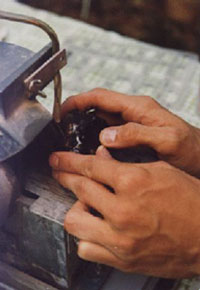
|
||||||
|
|
||||||
|
|
|
Sawing gemstones
Several sizes of circular rock saws are frequently used by most gemcutters: (1) A slab saw, typically 16 to 24 inches in diameter, is used to cut stones of several inches thickness into relatively thin slabs--often 1/8 to 3/8 inch thick; (2) A trim saw, typically 6 to 10 inches in diameter, is used to cut smaller stones into thin slabs or to cut small sections out of slabs; and (3) A faceter's trim saw, typically 4 inches in diameter, is used with a very thin blade, to saw small pieces of expensive rough. There are also jigsaws that employ either a reciprocating wire or a continuous thin metal band. These are useful for cutting curved lines that are impossible with circular saws. They are also useful in minimizing waste on extremely valuable rough material. All gems are cut and polished by progressive abrasion using finer and finer grits of harder substances. Diamond, the hardest naturally occurring substance, has a Mohs hardness of 10 and is used as an abrasive to cut and polish a wide variety of materials, including diamond itself. Silicon carbide, a manmade compound of silicon and carbon with a Mohs hardness of 9.5, is also widely used for cutting softer gemstones. Other compounds, such as cerium oxide, tin oxide, chromium oxide, and aluminum oxide, are frequently used in polishing gemstones.
|
||||
|
|
||||||
